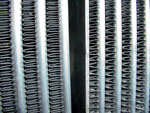

|
These two
pics. are of the three aluminium tubes we commonly use.
Left is a 16mm
tube. Mostly used in oe replacement applications ie:- Japanese 4 cyl..
We use it if we have a very big surface area to play with, weight is
paramount &/or the engine is running methanol (it runs much cooler). We
have our cores made with two rows of these tubes for some applications,
usually cost concious, giving a core thickness of 37mm.
Middle is a 29mm
tube. Mostly used in oe applications ie:- Commodore 6 cyl. We use it for
cores where we have a reasonable surface area. Our most common core is
two rows of these tubes, giving 57mm thick. This is as thick as
practical before problems with getting the air flow through the core &
the air becoming too hot in the core (to do any more cooling) actually
retard cooling.
Right is a 29mm
Dimple wall tube. Developed late '99 for the Group A race cars , this is
the most efficient cooling available. At 29mm it allows low restriction
air flow & as a two row 57mm thick core, still allows good air flow. The
tube gives 8 % better heat dissipation from the water. This is because
the dimples stamped into the tube side wall, break up the capillary wall
tension which in a plain tube causes the boundary layer of water to
cling to the tube inner wall & slowly move down the tube. This layer
gets nice & cool, but unfortunately, the majority of water passes down
the center of the tube without the advantage of contact with the tube
wall. |

N.B. This pic is of intercooler
cores, tubes are thicker, but fin variance shows up the same.
|
This pic. show
the difference in the range of fins per inch (fpi.) cores we can have
manufactured for us. The core on the left is 18fpi. and the core on the
right is 11fpi. , note that the manufacturer was a little more generous
with the outside row of fins in the 11fpi. core
Usually, the more fpi. a
core has , the better the heat dissipation rate is, until the closeness
of the fins to the thickness of the core ratio is too high and starts
restricting the volume of air passing across the fins. Air is like water
& takes the least path of resistance, so the thicker the core/closer the
fin pitch, the more the air tries to go around the radiator. Foam is
often used by manufacturers to seal any gaps, to force the air through a
radiator. As always, maximum cooling is a compromise!
Unfortunately, I have had
to use intercooler cores in this pic, so the tubes are much bigger, but
the fin pitch variance shows up the same.
|